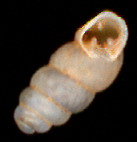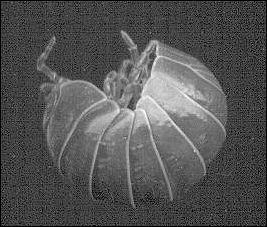
In common with other habitats, desert terrestrial and aquatic habitats have numbers of kinds and numbers of individuals of invertebrate animals far greater than those of vertebrates. Likewise, an argument can be made that invertebrates play a far greater role in the desert biome than do vertebrates. Nonetheless, we'll consider only a very small subsample and limit ourselves to a few of the more dramatic forms.
Most mollusks are marine and most non-marine mollusks are aquatic. Thus it might be expected that deserts would be nearly devoid of mollusks. In actuality, there are aquatic taxa in rivers and other bodies of water and a surprising number of terrestrial forms.
The class Gastropoda (literally, stomach foot) includes the snails and slugs. Although some aquatic snails occur in the Chihuahuan Desert, most of the gastropod fauna is terrestrial and belongs to the subclass Pulmonata. The name is in reference to the lung-like structure used for breathing air by all of the northern desert land species. Keys for identification are given by Metcalf and Smartt (1997). A variety of aquatic snails from Cuatro Cienégus is shown on the Cuatro Cienégus website.
 Metcalf and Smartt (1997) note that the open grassland and scrub of the desert support relatively few snails. Many of those that are present are small to minute. Mountain ranges in the northern desert have a more diverse gastropod fauna. and many have endemic species (species that occur nowhere else). The dry season usually is spent in aestivation: a dormant state similar to hibernation in vertebrates. The snail retreats to as protected a place as may be available, and the aperture to the shell is sealed by secretions that act to slow desiccation. With the end of the dry season, the snail reactivates.
Metcalf and Smartt (1997) note that the open grassland and scrub of the desert support relatively few snails. Many of those that are present are small to minute. Mountain ranges in the northern desert have a more diverse gastropod fauna. and many have endemic species (species that occur nowhere else). The dry season usually is spent in aestivation: a dormant state similar to hibernation in vertebrates. The snail retreats to as protected a place as may be available, and the aperture to the shell is sealed by secretions that act to slow desiccation. With the end of the dry season, the snail reactivates.
Shell of a lowland terrestrial snail (Gastrocopta); actual size is about that of a grain of rice. Image by A.H. Harris.
Class Malacostraca: order Amphipoda ("amphipods" is as close as we come to a common name) includes small aquatic crustaceans found in Chihuahuan Desert springs. Genetic information on amphipods from these springs suggest each spring population has been isolated for a long period of time.
Springs are an endangered habitat in the Chihuahuan Desert, and so necessarily are their inhabitants.
Class Malacostraca: order Isopoda (wood lice). Most members of the Isopoda that live in the Chihuahuan Desert are terrestrial, but must live in moist habitats, necessary to keep the gills moist. The figure shows an isopod going into its defensive stance. The Socorro isopod, however, is aquatic. This endangered species lives only in one spring-fed area near Socorro, New Mexico.
Class Branchiopoda: The most dramatic of the desert branchiopods is Triops. Triops lives in temporary pools that form during the rainy season. Eggs remain viable for many years with embryonic development held in stasis (diapause) until water once more is available, thus allowing the creatures to outlast droughts. One of the species of Triops is claimed to be the oldest living species at about 200 million years.
Other crustaceans are found in aquatic desert habitats, but the only other ones we'll consider briefly are members of the Decapoda (10 feet): in our case, crayfish (crawdads). Several species, including introduced species that may threaten freshwater communities, occur in the Chihuahuan Desert. One crayfish, Cambarellus chihuahuae, occurs only in Chihuahua, west of Villa Ahumada.
Last Update: 26 Jun 2006